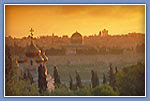What does it matter, who wrote the Torah (Pentateuch)? The Bible as we have it now is what we consider inspired, not the original writings behind the biblical text!
That is the perspective of some contemporary Catholic scholars, who hold that study of the text as it currently exists ought to be our guiding principle of interpretation, above the traditional historical-critical methods.
What difference does it make? A whole lot of difference.
Think of it as the difference between reading a news report about a ballgame and rooting for your team at the ballpark. Or the difference between being told about a birthday party after it happens and celebrating with your loved one in person. For me, it's the difference between reading about my parents' lives on email (they live3000 miles away) and spending time with them on vacation. The difference is HUGE.

Discovering how the Bible came to balance, on the one hand, the Yahwist’s (J’s) understanding of Yahweh as the God who he imagined “walking in the garden in the cool of the evening,” with, on the other hand, the Priestly writer’s (P’s) elevated understanding of God’s glory manifest in a luminous cloud (the Kavod Yahweh), is a journey that puts us in touch with the heart of God’s Word in a way that cannot be approached in any other way.
We must first separate the sacred text into its original literary strands before we can compare how different biblical authors experienced the profound religious insights of their times. And if you add into the mix the Elohist (E) and the Deuteronomist (D) you begin to get a glimpse of how the Pentateuch came to be a rich, vibrant tapestry of faith woven over centuries by human authors inspired by the Holy Spirit.
When we learn about the original context of the writings that came to make up Scripture, we enter into the ancient world in a way that, with persistent study and prayer, helps us to immerse ourselves in
how the writers of the Bible understood God, the faith community, and the role of individual leaders and families within the context of their relationships with God in the faith community.
The process of careful study of the historical development behind our sacred canon allows us to encounter God in new (old) ways, to see how our current way of worshiping, understanding, and relating to God has evolved through history. We can recapture insights that may not be currently apparent in our lives and communities and in this way deepen our own relationship with God—as individuals and as a community.

This is one reason why the Pontifical Biblical Commission asserts, in the first sentence of its landmark 1993 document,
The Interpretation of the Bible in the Church, that "the historical-critical method is the indispensable method for the scientific study of the meaning of ancient texts. Holy Scripture, inasmuch as it is the 'word of God in human language,' has been composed by human authors in all its various parts and in all the sources that lie behind them. Because of this, its proper understanding not only admits the use of this method but actually requires it."
Our understanding of what the Bible means today, as a whole and in its individual books, must rely on the interpretation of what the Bible meant to the original authors. In the Pentateuch (Torah), we have come to refer to some of the identifiable authors as "J, E, P, and D."















































